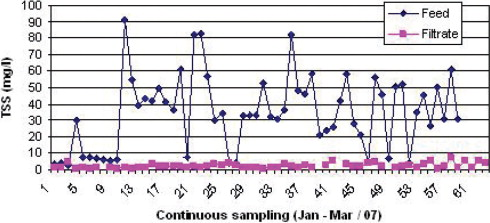
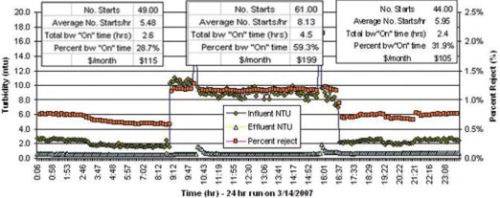
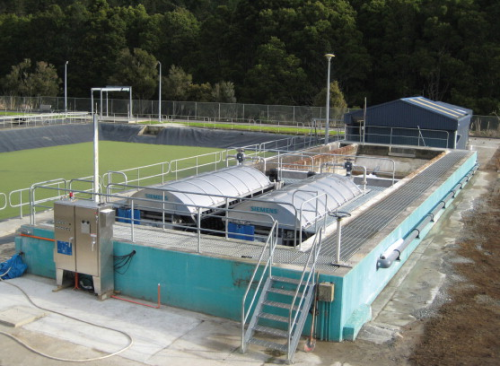
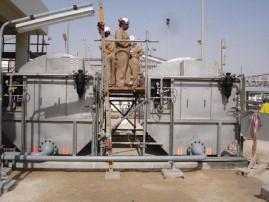
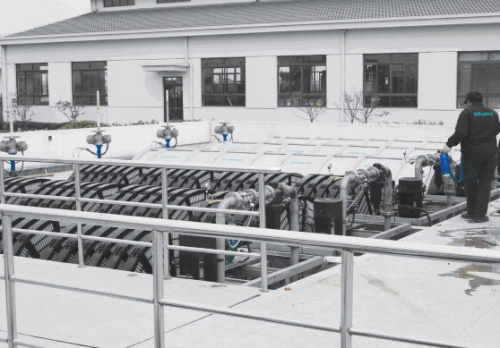
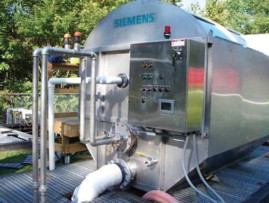
With disc filters, the difference in woven filtration media and flow pattern makes each technology unique to a particular application. Both inside-out and outside-in configurations perform to expectations, considering that these devices have been marketed for the relatively clean waters of municipal tertiary applications. However, the inside-out technique provides better sustainability and life cycle cost. One such device, the Forty-X disc filter from Siemens Water Technologies, can provide an economical and sustainable solution for municipal tertiary treatment applications.
Outside-In configuration
The first disc filter introduced to the US market used an outside-in flow scheme, in which the disc is completely submerged and the solids are filtered on the outside of the filtration medium, with the filtrate collected and conveyed inside a drum and out of the system. The accumulated solids are removed by reversing a portion of the filtrate flow through a shoe attached to the medium while rotating the whole drum/disc or rotating the backwash shoe on the stationary disc assembly.
The filtration medium consists of a pile cloth construction, which relies on the randomness of the fibres to capture and hold the solids. The cloth medium covers a honeycomb-shaped structure that is assembled around the filtrate drum/conduit. In this device, the medium suffers from the inability of the backwash shoe to keep it clean, mostly because it is submerged in an ever increasing concentration of feed solids. Thus, these filters are frequently complemented with sludge withdrawal systems and additional high pressure washing arrangements that complicate the overall system.
One major drawback of these systems is the biological growth that occurs in the inside face (the filtrate side) of the filter cloth, particularly common with un-chlorinated filter feed/secondary effluents. Another problem with the high pressure backwash of these systems is the need to shut down the process in order to accomplish the wash. Both of these drawbacks result in lengthy rinse periods, substantial reject volumes, and redundancy requirements in order to ensure continuous wastewater treatment.
Inside-Out configuration
A unique improvement was made to the disc filter with an outside-in configuration: the flow pattern was reversed by feeding the filtration medium from the inside, and partially submerging the outside of the medium in filtered water. This was accomplished by feeding a central drum/conduit with an opening to feed the filtration panels assembled in a disc pattern. Solids are deposited on the inside face of the medium, while filtrate is produced on the outside.
Backwash is initiated by headloss and is effected by high pressure nozzle sprays that dislodge the accumulated solids back in the direction of the feed and collect inside a trough located in the drum/conduit itself. The backwash spray is pulled from the same reservoir of product filtrate water as the disc/drum assembly is rotated. The medium is a woven polyester cloth with an absolute micron size rating (typically 10 microns for tertiary reuse). This absolute-micron size rating ensures that particles greater than the cloth opening size, as well as those greater than the available opening of the accumulation in the medium, are retained.
This medium is assembled into filter panels, which are inserted into plastic boxes that surround the feed drum/conduit in a disc configuration. Each disc is composed of 28 filter panels. Since the discs are in filtrate water only, there is no need for sludge removal mechanisms, resulting in a much simpler system. Pleated filtration panel innovation
Both the inside-out and outside-in techniques rely on filtration media configured in a flat panel design. The effective filtration area is therefore the available area that is perpendicular to the direction of flow, and should not account for any impervious surfaces of supporting structures such as frames, panel boxes, and metal works.
The disc filter with inside-out configuration brings a pleated design to the filtration panels, which increases the effective filtration area available by 40% over flat panel designs. This also increases the overall strength of the filtration panel, which allows it to sustain higher operating headloss. The pleated configuration makes the filtration panel less prone to deformities of the cloth media.
The combination of higher filtration surface area and stronger configuration of the disc filter results in a high throughput capacity. In addition, the filtration panel's seals are water pressure-assisted, which increases the robustness of the seal and eliminates the many leak points inherent in flat panel designs. To further complement the design of the filtration panels, the filtration boxes (the panels' housing) are designed to be trash tolerant. Existing flat panel technology has internal gussets inside its filtration boxes that provide surfaces for large inorganic material such as plastics, algae strings, rags and other floatables to hang on, accumulate and affect the internal hydraulics of the filtration panels. The disc filter's filtration box does not have these internal gussets; consequently, there is a free and uninterrupted pathway for this unwanted material to flow and be rejected from the system.
The internal assembly of the disc/drum has a sliding cover of stainless steel. This sliding cover eliminates the need to lift a heavy cover, and it exposes sections of the disc assembly for ease of inspection and maintenance. This is a benefit for installations that are outside and in windy environments. Typical performance
The Forty-X disc filter was tested with a production unit for several months at the City of Thomasville, Georgia, U.S. Pollution Control Facility. The facility consists of trickling filter treatment followed by bubble aeration secondary effluent. The test was designed to challenge the unit's performance and determine operating parameters. A portion of the test included feed solids spike conditions. Figure 1 shows a typical Total Suspended Solids (TSS) performance trend achieved from the full scale test.
Regardless of the feed concentration, effluent TSS is consistently low due to the finite opening of the woven cloth medium. This curve was generated at hydraulic loadings of 6 gpm/sq.ft., of true and effective filter area and 50% submergence. As would be expected, the higher the solids load, the more backwash volume is required to keep the media clean. Figure 2 shows the low percentage of reject generated as a function of the turbidity. The filter generates low reject volumes that are typically 1.5% or less. There is also a low annual cost associated with the automatic operation of the backwash pump in relation to the turbidity events.
Case studies
New Zealand
This facility needed a capacity expansion to address growth and new consent decrees. Unfortunately, a lack of available land prevented the addition of more concrete-style travelling bridge filters to the plant design. As a result, the existing travelling bridge filters were retrofitted with Forty X disc filters (see Figure 3). The facility was able to accommodate two Forty X disc filters in half the space occupied by the travelling filters, to increase plant capacity. Furthermore, the pleated configuration of the filtration panels allowed a 40% increase in filtration area with fewer disc filters. This left room to add additional discs to meet future flow requirements without the need to modify the structure or the filter system.
Qatar, U.A.E.
A multinational petroleum venture in the U.A.E. needed to expand its facility while treating for reuse two separate waste streams generated by the chemical facility. The expansion was complicated due to space constraints and water availability. One stream had domestic wastewater components and only required typical tertiary treatment to comply with reuse standards, while the other required further treatment by ultrafiltration (UF) membranes in order to be reused in the facility. The facility was fitted with the space saving disc filters, shown in Figure 4. The absolute micron rating of the woven polyester cloth in the filtration panel allowed consistent effluent quality, despite the variation of the influent concentration. This allowed both an increase in flux and a decrease in UF Clean in Place (CIP) events, resulting in a more economical and sustainable operation.
Kuwait
In order to address infrastructure growth requirements, Kuwait has planned a modern 72-mgd wastewater facility. The specifiers chose the disc filter, because they recognised the value of the pleated filtration panel in this high flow treatment application. The 40% increase in the filtration area over flat panel designs resulted in the need for fewer unit processes, which in turn saved on footprint, civil works and overall installation cost. Besides the disc filters, Siemens provided its Bio-Flowsheet solution that included Vertical Loop Reactors with fine bubble screens, and clarifiers.
China
The problem with many infrastructure renovation projects in very densely populated areas is the lack of available space. This was the case with an upgrade for one of Wuxi, China's major wastewater treatment facilities. As there was no room to include a filtration step, the facility decided to retrofit the existing concrete chlorine contact chamber with disc filters and ultraviolet (UV) disinfection (see Figure 5). A combination of the shallow profile of the disc filter and the 600 sq.m (1234 sq.ft.) of surface area available in the filters' pleated configuration, allowed capacity expansion in the existing concrete chlorine basin footprint.
Italy
Recent years of drought combined with an increased demand for potable irrigation water have left many parts of Italy, particularly the agricultural rich southern portion, to focus on wastewater reuse. Over a dozen disc filter installations are scheduled for start-up in the near future for several communities and service providers.
Pennsylvania, U.S.
A sequencing batch reactor (SBR) facility was in dire need of improving its Total Suspended Solids (TSS) removal in the absence of a properly functioning slow sand filter. The solution was a ‚plug and play’ installation consisting of a disc filter placed on top of the existing SBR equalisation tank (see Figure 6). The small footprint of the filter saved the facility additional civil work, all within the plant's hydraulic profile that included existing UV disinfection equipment.
Georgia, U.S.
This facility received limited funding for equipment and capacity upgrades. The two existing travelling bridge filters, which were in need of extensive repairs and could not achieve the new capacity requirements, were dismantled and replaced with two disc filters. Another ‚plug and play’ example, this installation was done without having to change the piping structures that fed the old filters.






